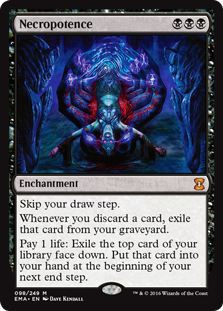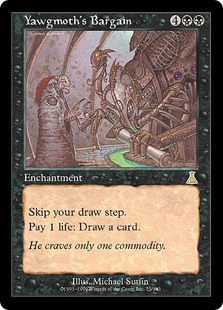Oversoul
The Tentacled One
First, I want to get one thing out of the way, and it's a big thing: Necropotence. When either of these cards come up in any context outside of the use of Necropotence in the mid-90's before Bargain existed, the comparison between the cards almost inevitably follows. And before today, I had this idea in mind that Necropotence was going to have to be one of the next cards that I'd talk about; I envisioned it as "next in the queue" for a Magic Memories thread. I kept putting it off, mostly because I figured that once I started talking about Necropotence, it would be impossible to get me to shut up about it. I've vacillated on whether my personal favorite card is Dark Ritual or whether it's Necropotence, as the two are so closely linked in my mind: I played them together a lot. But Dark Ritual, well, there's only so much to say about it, because it only has a few different uses, and all of those involve using it to enhance the value of some other card, so my Dark Ritual memories are more about the cards that I used Dark Ritual to power out than they are about Dark Ritual itself. I could have come up with more to say about it, and perhaps I will revisit the Dark Ritual thread, but I think I covered the important parts. Necropotence, though? I could write a novel. I'm worried that I might!
So when I mention Bargain, Necropotence as a point of comparison seems like a given. I've seen others do so when discussing Bargain. To top it off, both cards are banned in Legacy and restricted in Vintage where, historically, they've been used alongside each other in "TPS" or "DPS" decks (almost every TPS/DPS deck runs a copy of both enchantments, and hardly any other decks in the format run either one). But for me, it actually goes beyond that. I talked about this in the Academy Rector thread...


Well, enough about Necropotence! For now. Mostly. Maybe. Look, I make no promises. Anyway, I'm starting a thread on Yawgmoth's Bargain largely because in the past few months I've encountered some isolated mentions of the card as it pertains to different formats, and that's been brewing in my mind. Specifically, I've seen other people who are not me cite the card as a possible safe unrestriction in Vintage, as a safe unban in Legacy, and as a safe unban in Commander. The contexts of the card in those formats were each brought up by different individuals, none of them connected to each other (as far as I can tell). I have my own opinions for each case, but also a lot of uncertainty and trepidation.
So when I mention Bargain, Necropotence as a point of comparison seems like a given. I've seen others do so when discussing Bargain. To top it off, both cards are banned in Legacy and restricted in Vintage where, historically, they've been used alongside each other in "TPS" or "DPS" decks (almost every TPS/DPS deck runs a copy of both enchantments, and hardly any other decks in the format run either one). But for me, it actually goes beyond that. I talked about this in the Academy Rector thread...
We played various versions of those decks against each other so much. It was a formative experience for both of us and definitely cemented my obsession with Necropotence, which I harbor to this day. So yeah, when I talk about Yawgmoth's Bargain, Necropotence is inherently the elephant in the room. I suppose that I'd better do a quick, simplistic, side-by-side comparison of the two...In 1999, a friend I used to trade with a lot took a fancy to my playset of Necropotence (I think he wanted to play Necro in Extended) and tried to sell me on Yawgmoth's Bargain as a better version, but I didn't go for it. Later Nick (Al0ysiusHWWW) got those copies of Bargain. From late 1999 through 2000, he had a black/white Bargain deck. Serra Avatar was his go-to kill condition. This was the beginning of "Necro vs. Bargain Wars." My best deck was a Necro deck. His best deck was a Bargain deck. We'd binge playing Magic against each other all weekend, sometimes pitting our best decks against each other over and over for hours. In the summer of 2000, Nick's dad took us on a road trip through the midwest, and we spent a lot of the time playing Necro against Bargain in the back of a van, with cards laid out on pillows on our laps. We tinkered with our decks over that span of time, not fine-tuned for that particular matchup, but exploring general possibilities, so the advantage in this matchup oscillated haphazardly. For most of this time, my monoblack Necro deck was able to get going a bit faster, with more creatures and more control elements. But once Nick got going with Bargain and Ivory Tower, he could gain so much life that I couldn't kill him. I vaguely remember an arms race of various tools we tried against each other. He could throw up Academy Rector as a roadblock to my attackers, then try to go off with Bargain. So I tried to blow up his board with Nevinyrral's Disk and beat him to death before he could set up a big life gain loop. But he could take out my Disk with Seal of Cleansing. I don't remember if Academy Rector was a participant in Necro vs. Bargain Wars for the entirety of the run: Nick changed his deck many times and might have eventually cut the card for some other approach. The rivalry between the decks eventually sort of faded away as the gradual accumulation of changes caused the decks to diverge and move toward other purposes (Nick's Bargain deck was broken up to create new decks and my Necro deck became a blue/black prison build with Zur's Weirding).
- Bargain costs twice as much.
- Necropotence exiles the cards that you discard, which sometimes matters.
- Necropotence does not actually draw cards, but sets them aside and then later puts them into your hand, which can matter, especially when other cards have abilities that are triggered when players draw cards.
- Necropotence hides the cards from you until the end of your turn. You cannot look at them and do not know what you will or will not get, only how many cards you're getting.
- Bargain gives you cards right away, whenever you activate it. Opponent's turn? Fine. During your upkeep with Ivory Tower's ability on the stack? Go for it. Found exactly the card that you want? Feel free to stop.
Well, enough about Necropotence! For now. Mostly. Maybe. Look, I make no promises. Anyway, I'm starting a thread on Yawgmoth's Bargain largely because in the past few months I've encountered some isolated mentions of the card as it pertains to different formats, and that's been brewing in my mind. Specifically, I've seen other people who are not me cite the card as a possible safe unrestriction in Vintage, as a safe unban in Legacy, and as a safe unban in Commander. The contexts of the card in those formats were each brought up by different individuals, none of them connected to each other (as far as I can tell). I have my own opinions for each case, but also a lot of uncertainty and trepidation.
